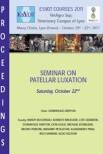Objectives: To describe a computed tomographic (CT) methodology for planning the correction of femoral and tibial torsion and report the clinical outcomes after femoral (FDO) and tibial (TDO) detorsional osteotomy in dogs affected by torsion malalignment and patellar luxation (PL).
Study design: Multicenter retrospective study.
Animals: Eighteen client-owned dogs.
Methods: Dogs underwent CT to measure femoral (FTA) and tibial torsion angle (TTA). Abnormal femoral external torsion was defined when FTA <20°, abnormal femoral internal torsion if FTA >35°; abnormal tibial external torsion was defined when TTA < -10°, and abnormal tibial internal torsion when TTA >2°. The cortical arch length (CAL) was measured with CT and used intraoperatively to determine the magnitude of correction. The medical records and radiographs were reviewed and used to report clinical and radiographic outcomes. Radiographs were reviewed to evaluate postoperative limb alignment, patellar position, and bone healing.
Results: Twenty-two detorsional osteotomies were performed. Mean preoperative FTA was 14° for medial-PL and 45.2° for lateral-PL. Mean preoperative TTA was 11° for medial-PL. Physiological patellar tracking was restored in 22/22 of cases. CAL measurement allowed for correction of abnormal torsion in 19/22 of cases. Seventeen out 18 dogs had full or acceptable functional outcome. The median radiographic follow-up was 3 months. Major complications occurred in 2/22 cases, which suffered an iatrogenic abnormal femoral internal torsion and a persistent hindlimb lameness.
Conclusions: CAL can be measured with CT and used intraoperatively to guide the correction of abnormal torsion in dogs.
Clinical relevance: Abnormal femoral and tibial torsion are predisposing factors for PL. A higher complication rate is expected when FDO and TDO are performed in the same hindlimb.









